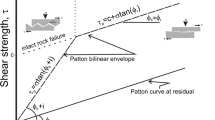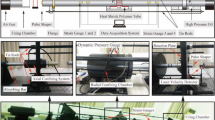Abstract
Rockbolts are widely used as an underground support element to resist the convergence and maintain the stability of excavations. However, shear failure of rockbolts is increasingly observed in jointed rock mass of underground tunnels, especially after being subjected to seismic events. At present, understanding of the mechanical response of rockbolts subjected to seismic or dynamic loading in shear is still unclear. To investigate the shear performance of rockbolts under dynamic loading condition, a series of tests were conducted using a drop mass of up to185 kg from a maximum height of 3 m based on a double shear test (DST) system. Three variables were examined in the laboratory test including rockbolt diameter (8 mm and 16 mm), installation angle (90° and 45°) and input energy (drop height). The duration of the impact was 10–12 ms from release of the drop mass to first contact. By evaluating the DST system’s displacement/velocity/acceleration–time characteristic and the amount of energy absorption, the shear performance of rockbolt was assessed. When sufficient energy is applied into the DST system, the deformation of the rockbolt is dominated by localized shear force. The transient force can rupture the rockbolt with little bending and without any obvious tensile elongation. It was found that the averaged dynamic shear load is less than the peak static shear load whether horizontally installed or installed at an angle. In conclusion, the effectiveness of rockbolts in resisting shear stress can differ significantly under static loading and dynamic loading condition; the difference is reflected in the level of shear deformation and amount of energy absorption. The shear capacity of a rockbolt under 1 s−1 strain rate can be determined by the energy absorbed and average dynamic load. This approach can be applied to the support system design in rockburst-prone condition.
























Similar content being viewed by others
Abbreviations
- M 1 :
-
A drop weight mass
- M 2 :
-
The mass of middle block including the rockbolt
- v 1 :
-
Initial velocity
- v 2 :
-
The downward move velocity of the two rigid solids (weight and reinforced block)
- \({F_{\text{a}}}\) :
-
The average dynamic force
- \(\Delta v\) :
-
Velocity change
- (M 1 + M 2)g :
-
The downward force includes the weight of the tup and middle block
- F d(t):
-
External dynamic force
- F b(t):
-
Upward force includes bolt resistant force
- µN :
-
Frictional force on the block surface
- p(t):
-
Time-dependent force
- f s(t):
-
The combination of the system spring force
- f D(t):
-
Viscous damping force
- f I(t):
-
Inertial force
- p :
-
Contact force
- k :
-
Contact stiffness
- R :
-
The radii of the curvature of the body
- E :
-
Young’s modulus and
- v :
-
Poisson’s ratios
- f y :
-
The static yield stress of the bar (MPa)
- DIF:
-
Dynamic increase factor
- \(\dot {\varepsilon }\) :
-
Strain rates
- \({\varepsilon _{\text{p}}}\) :
-
True strain
- \({\dot {\varepsilon }_0}\) :
-
Reference value of the strain rate
- T :
-
Temperature
- \({T_{{\text{room}}}}\) :
-
Room temperature
- \({T_{{\text{melt}}}}\) :
-
Melting temperature
References
Abrate S (2001) Modeling of impacts on composite structures. Compos Struct 51:129–138. https://doi.org/10.1016/S0263-8223(00)00138-0
Argyris JH (1991) Dynamics of structures. North-Holland, New York
Aziz N, Pratt D, Williams R (2003) Double shear testing of bolts. In: Aziz N (ed) Coal operators’ conference, Wollongong, Australia, pp 154–161
Bischoff PH, Perry SH (1991) Compressive behaviour of concrete at high strain rates. Mater Struct 24:425–450. https://doi.org/10.1007/BF02472016
Chung HW (1978) Shear strength of concrete joints under dynamic loads. Concrete 12:27–29
Grasselli G (2005) 3D behaviour of bolted rock joints: experimental and numerical study International. J Rock Mech Mining Sci 42:13–24. https://doi.org/10.1016/j.ijrmms.2004.06.003
Guner S, Vecchio FJ (2012) Simplified method for monlinear dynamic analysis of shear-critical frames. ACI Struct J 109:10
Hadjigeorgiou J, Potvin Y (2011) A critical assessment of dynamic rock reinforcement and support testing facilities. Rock Mech Rock Eng 44:565–578. https://doi.org/10.1007/s00603-011-0155-4
Haile AT (1999a) A mechanistic evaluation and design of tunnel support systems for deep level South African mines. PhD thesis (unpublished), University of Natal
Haile AT (1999b) Observation of the dynamic support performance of South African tunnel support systems. In: Villaescusa E, Windsor CR, Thompson A (eds) Rock support and reinforcement practice in mining, Kalgoorlie, Australia, pp 335–341
Jalalifar H (2006) A new approach in determining the load transfer mechanism in fully grouted bolts. PhD thesis (unpublished), University Of Wollongong
Johnson GR, Cook WH (1983) A constitutive model and data for metals subjected to large strains, high strain rates and high. In: The 7th international symposium on ballistics, pp 541–547
Kim J-H, Kim D, Han HN, Barlat F, Lee M-G (2013) Strain rate dependent tensile behavior of advanced high strength steels: experiment and constitutive modeling. Mater Sci Eng A 559:222–231. https://doi.org/10.1016/j.msea.2012.08.087
Kong S, Remennikov A, Uy B (2013) An experimental investigation of the performance of non-composite steel–concrete–steel protective panels under large impact loading. Adv Struct Eng Int J 16:1163–1174
Li C (2011) Rock support for underground excavations subjected to dynamic loads and failure. Adv Rock Dyn Appl. https://doi.org/10.1201/b11077-19
Li L, Hagan P, Saydam S (2014) Tensile stress mobilization along a rockbolt under shear load. In: Cai M (ed) International young scholars’ symposium on rock mechanics, Xi’an, China
Li L, Hagan P, Saydam S, Hebblewhite B (2016) Shear resistance contribution of support systems in double shear test. Tunnel Undergr Space Technol 56:8
Malvar LJ (1998) Review of static and dynamic properties of steel reinforcing bars. Mater J 95:609–616. https://doi.org/10.14359/403
Malvar LJ, Crawford JE Dynamic increase factors for steel reinforcing bars. In: Twenty-Eighth DoD Explosives Safety Seminar, Orlando, United State, 1998. Naval Facilities Engineering Service Center
Potvin Y, Wesseloo J, Heal D (2010) An interpretation of ground support capacity submitted to dynamic loading. Trans Inst Mining Metall Sect A Mining Technol 4:233–245
Qin J, Chen R, Wen X, Lin Y, Liang M, Lu F (2013) Mechanical behaviour of dual-phase high-strength steel under high strain rate tensile loading. Mater Sci Eng A 586:62–70. https://doi.org/10.1016/j.msea.2013.07.091
Roberts D (1999) Dynamic double shear test. PhD thesis (unpublished), University of KwaZulu-Natal
Saatci S (2007) Behaviour and modeling of reinforced concrete structures subjected to impact loads. PhD thesis (unpublished), University of Toronto
Stacey TR Support of excavations subjected to dynamic loading. In: Qian Q, Zhou Y (eds) 12th ISRM International Congress on Rock Mechanics, Beijing, China, 2011. International Society for Rock Mechanics, ISRM
Staker MR (1985) Mechanical testing; chapter: introduction to high strain rate testing, 9th edn. ASM International, New York
Tannant DD, Brummer RK, Yi X (1995) Rockbolt behaviour under dynamic loading: field tests and modelling. Int J Rock Mech Mining Sci Geomech Abstracts 32:537–550. https://doi.org/10.1016/0148-9062(95)00024-B
Zembaty Z (2011) How to model rockburst seismic loads for civil engineering purposes? Bull Earthq Eng 9:1403–1416. https://doi.org/10.1007/s10518-011-9269-z
Author information
Authors and Affiliations
Corresponding author
Ethics declarations
Conflict of interest
All authors declare that they have no conflict of interest.
Additional information
Publisher’s Note
Springer Nature remains neutral with regard to jurisdictional claims in published maps and institutional affiliations.
Rights and permissions
About this article
Cite this article
Li, L., Hagan, P.C., Saydam, S. et al. A Laboratory Study of Shear Behaviour of Rockbolts Under Dynamic Loading Based on the Drop Test Using a Double Shear System. Rock Mech Rock Eng 52, 3413–3429 (2019). https://doi.org/10.1007/s00603-019-01776-x
Received:
Accepted:
Published:
Issue Date:
DOI: https://doi.org/10.1007/s00603-019-01776-x




